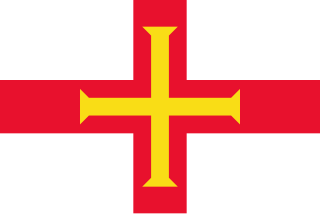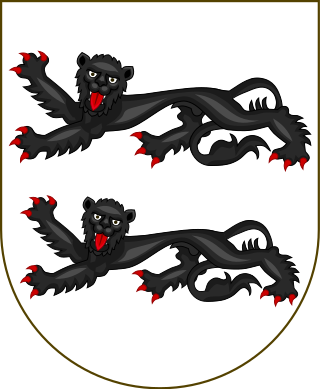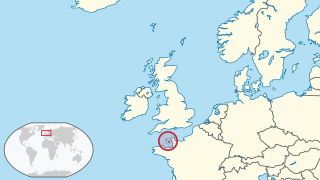| Coat of arms of Guernsey | |
|---|---|
 | |
| Shield | Gules, 3 lions passant guardant Or, langued and armed Azure. |
The coat of arms of Guernsey is the official symbol of the Channel Island of Guernsey. It is very similar to the arms of Normandy, Jersey, and England.
| Coat of arms of Guernsey | |
|---|---|
 | |
| Shield | Gules, 3 lions passant guardant Or, langued and armed Azure. |
The coat of arms of Guernsey is the official symbol of the Channel Island of Guernsey. It is very similar to the arms of Normandy, Jersey, and England.
The Seal of Guernsey closely follows the coat of arms; it originates from 1279 when a single seal was provided by Edward I for joint use in Guernsey and Jersey. The seal comprised 3 Luparts, meaning leopards (or lions). [1] : 5 By 1304 separate seals were provided for each Bailiwick.
The shape of the sprig or " rameau " on the top of the seal has changed over the centuries. Bailiff Daniel de L'Isle Brock commissioned a replacement seal in 1832, the lions or leopards becoming a caricature of true heraldic beasts. The head of the beasts took on a shape approximating to that of a shield, the mane was virtually non-existent, the body was somewhat extended, and the legs were so thin they could not carry an animal. Bailiff Sir Edgar McCulloch in 1884 reverted to the traditional heraldic representation. [2]

The Channel Islands are an archipelago in the English Channel, off the French coast of Normandy. They are divided into two Crown Dependencies: the Bailiwick of Jersey, which is the largest of the islands; and the Bailiwick of Guernsey, consisting of Guernsey, Alderney, Sark, Herm and some smaller islands. Historically, they are the remnants of the Duchy of Normandy. Although they are not part of the United Kingdom, the UK is responsible for the defence and international relations of the islands as it is for the other Crown Dependency, the Isle of Man, and the British Overseas Territories. The Crown Dependencies are neither members of the Commonwealth of Nations, nor part of the European Union. They have a total population of about 171,916, and the bailiwicks' capitals, Saint Helier and Saint Peter Port, have populations of 33,500 and 18,207 respectively.

The flag of Guernsey was adopted in 1985 and consists of the red Saint George's Cross with an additional gold Norman cross within it. The creation was prompted by confusion at international sporting events over competitors from Guernsey and England using the same flag. It was designed by the Guernsey Flag Investigation Committee led by Deputy Bailiff Sir Graham Dorey. The flag was first unveiled on the island on 15 February 1985. The gold cross represents William the Bastard, Duke of Normandy. William purportedly was given such a cross by Pope Alexander II and flew it on his standard in the Battle of Hastings. Since 2000, a red ensign with the cross in the fly has been used as the government's civil ensign and as a blue ensign.
The Crown Dependencies are three offshore island territories in the British Islands that are self-governing possessions of the British Crown: the Bailiwick of Guernsey and the Bailiwick of Jersey, both located in the English Channel and together known as the Channel Islands, and the Isle of Man in the Irish Sea between Great Britain and Ireland.
The Bailiff is the chief justice in each of the Channel Island bailiwicks of Guernsey and Jersey, also serving as president of the legislature and having ceremonial and executive functions. Each bailiwick has possessed its own bailiff since the islands were divided into two jurisdictions in the 13th century. The bailiffs and deputy bailiffs are appointed by the Crown on the advice of the Secretary of State for Justice and may hold office until retirement age.

The Bailiwick of Guernsey is a self-governing British Crown Dependency off the coast of Normandy, France, comprising several of the Channel Islands. It has a total land area of 78 square kilometres (30 sq mi) and an estimated total population of 67,334.

The flag of Jersey is composed of a red saltire on a white field. In the upper quadrant the badge of Jersey surmounted by a yellow "Plantagenet crown". The flag was adopted by the States of Jersey on 12 June 1979, proclaimed by Queen Elizabeth II on 10 December 1980 and first officially hoisted on 7 April 1981.
A bailiwick is usually the area of jurisdiction of a bailiff, and once also applied to territories in which a privately appointed bailiff exercised the sheriff's functions under a royal or imperial writ.

The lieutenant governor of Jersey, properly styled the lieutenant-governor of Jersey, is the representative of the British monarch in the Bailiwick of Jersey, a dependency of the British Crown.

The lieutenant governor of Guernsey is the representative of the British monarch in the Bailiwick of Guernsey, a Crown dependency of the British Crown. The role of the lieutenant governor is to act as the de facto head of state in Guernsey and as liaison between the governments of Guernsey and the United Kingdom. The holder of this office is also ex officio a member of the States of Guernsey but may not vote and, by convention, speaks in the Chamber only on appointment and on departure from post. The duties are primarily diplomatic and ceremonial. He has the authority to appointment two members of the board of governors of Elizabeth College and the Priaulx Library.

The coat of arms of Jersey is the heraldic device consisting of a shield charged with three gold lions on a red field. Utilised unofficially before the 20th century, its status as the coat of arms of the Bailiwick of Jersey was formalized in 1907. The escutcheon is featured on the flag of the dependency.

The lion is a common charge in heraldry. It traditionally symbolises courage, nobility, royalty, strength, stateliness and valour, because historically the lion has been regarded as the "king of beasts". The lion also carries Judeo-Christian symbolism. The Lion of Judah stands in the coat of arms of Jerusalem. Similar-looking lions can be found elsewhere, such as in the coat of arms of the Swedish royal House of Bjelbo, from there in turn derived into the coat of arms of Finland, formerly belonging to Sweden.

The leopard in heraldry is traditionally depicted the same as a lion, but in a walking position with its head turned to full face, thus it is also known as a lion passant guardant in some texts, though leopards more naturally depicted make some appearances in modern heraldry. The Oxford Guide to Heraldry makes little mention of leopards but glosses leopard as a "term used in medieval heraldry for lion passant guardant. Now used for the natural beast." Another name for this beast is the ounce.

The following outline is provided as an overview of and topical guide to Guernsey:

The following outline is provided as an overview of and topical guide to Jersey:

The national flag of Sark consits of a white background with a red St. George's cross and a red canton containing the two yellow lions from the flag of Normandy. This version of the flag was officially granted in 2020.
This gallery shows the coat of arms of each of the Dependent territories in the list of countries.

The first postal service took place using mail sent with captains of packet ships, using agents in the England and in the islands for the end delivery. The cost was normally 3d. The first pillar boxes in Britain were introduced in the Channel Islands as an experiment in 1852, to collect mail for the Royal Mail packet boats. The oldest pillar box in use in the British Isles is in Guernsey.

The history of the Jews in Guernsey dates back to well before the events of 1940–5. A London Jew named Abraham was described in 1277 as being from "La Gelnseye" (Guernsey). A converted Portuguese Jew, Edward Brampton, was appointed Governor of Guernsey in 1482.

The Law of Guernsey originates in Norman customary law, overlaid with principles taken from English common law and French law, as well as from statute law enacted by the competent legislature(s) – usually, but not always, the States of Guernsey.